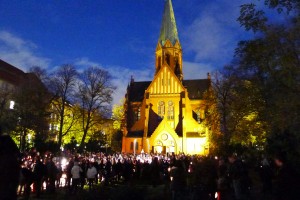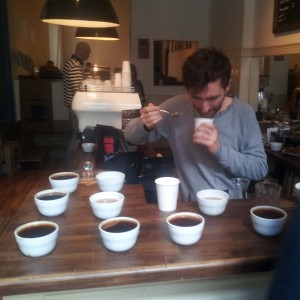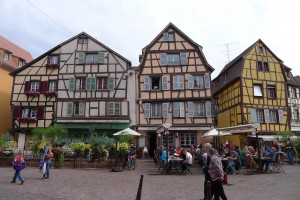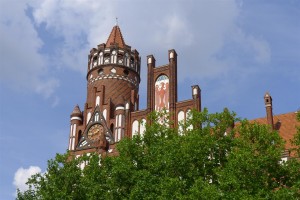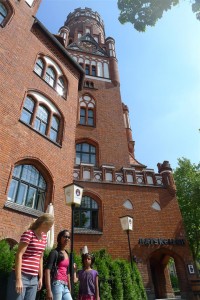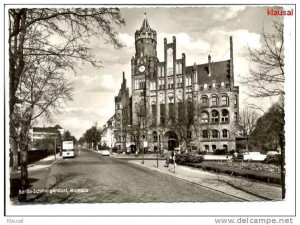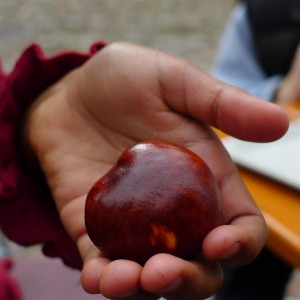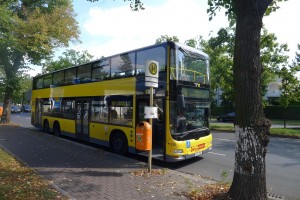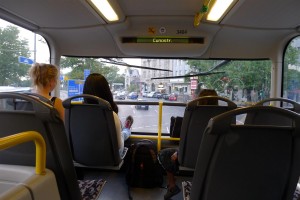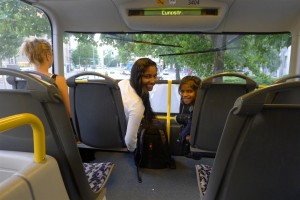On the evening of November 11, Mamta took to the streets to celebrate Saint Martin’s Day — Martinstag — with her cousins. Prior to the day, I was not familiar with Saint Martin or the celebration. When I asked my sister-in-law Doreen about Saint Martin, she gave me a one-sentence summary: “He was a Roman soldier who shared his cloak — by cutting it in half — with a beggar on a cold winter evening.” It turns out that’s not all he did, but that act of generosity is re-enacted annually in Saint Martin’s Day celebrations across Germany.
Category Archives: Personal
The Cupping
I recently came across an article that likened certain sections of Berlin (“Berlyn”) to Brooklyn, NY. Apparently there is a good deal of cross-pollination occurring between these two urban hotspots. The other day I was invited by a friend to attend a coffee tasting in Penzlauer Berg, a neighborhood that has been compared to Brooklyn’s Park Slope. Or Williamsburg, I thought as I entered the shrine to coffee known as Cafe ck.
The coffee aroma in the cozy cafe was compelling. Soul music — Mavis Staples, James Brown — spun on a turntable tucked beneath the rear counter. A small shelf displayed trophies and plaques from various coffee-related competitions. The two bearded, twenty-something baristas behind the counter executed their work with earnest precision.
This was my first coffee tasting, or “cupping,” as I learned to call it. The eight participants included several other neophytes. We could tell the veteran cuppers: they had brought small notebooks in which to record their tasting notes.
Last Night in the Subway
Last night Mamta and I came home late from her cousin Jonas’s birthday party. It took me a while to peel Mamta away from the movie — How to Train Your Dragon — that she and the other kids were watching. Annette had gone home ahead of us by bike.
Mamta rode her scooter to the subway station and I jogged alongside her. As we descended the stairs, we saw two workers in red overalls operating commercial floor scrubbing equipment by the ticket machine. They were just finishing cleaning the tile floor of the subway platform. The damp tiles glistened, and the scent of detergent hung in the air.
Mamta and I jostled for dibs on the ticket machine, and I then grabbed her scooter and rolled down the brightly-lit platform. We could see from the signboard above the platform that our train would be arriving in three minutes. We were the only people waiting for the train.
I started scootering around one of the columns in the middle of the platform — and wiped out on the slick tiles. I sheepishly arose, and Mamta took over the scooter. We ended up chasing each other in circles around the column. When we heard the train approaching, we stopped and folded up the scooter.
“Hey,” I heard a voice call out to us as we headed for the train. It was one of the workers we had seen operating the cleaning equipment. A young guy. Serious. “You shouldn’t be fooling around like that on the subway platform. It’s not a playground.”
I was — the word in German is “verblüfft.” A combination of taken aback, amazed and bewildered. I was also touched by his concern, and slightly amused. I didn’t consider what Mamta and I had been doing to be at all risky or dangerous. On the other hand, accidents do happen.
“Ja, Sie haben Recht,” I replied. You’re right. With appreciation for Germany’s culture of order, I hustled to join Mamta on the train.
Halloween
Our hometown of Walpole, New Hampshire sets a high bar when it comes to Halloween. Many people decorate their houses, some of the parents dress up, and the village is swarming with elaborately-costumed kids. Typically I will don a simple costume and man our front porch with a mechanical skeleton that declares: “Do not be afraid!” Most kids aren’t. One year we had so many trick-or-treaters that I ran out of candy, and had to replenish our bowl with treats that Mamta had gotten at other houses. While I am meeting and greeting kids at the front door, Annette hosts our adult guests back in our kitchen, treating them to mulled wine and Hungarian goulash (ghoulash?) soup.
I could tell from the lack of build-up that Halloween was not going to amount to much here in Berlin. A week ago I saw in our local office supply store a small display of plastic pumpkins and miscellaneous spooky trinkets. When I returned there today to buy the one witch hat I had seen, the entire display was gone, replaced by Christmas decorations. But it’s only Halloween!
Swimming Lessons with Jürgen
Yesterday Mamta swam for ten minutes with her clothes on. Her pajamas, actually. No, she hadn’t sleep-walked to the Grunewald See. She was at her weekly swimming lesson with Jürgen, swimming coach to the stars.
We found Jürgen’s swim class through Annette’s sister Doreen. Two of Doreen’s children were already progressing under his tutelage. Annette took Mamta to her first class about six weeks ago.
“Ja,” said Jürgen with unvarnished disdain after first watching Mamta swim, “she clearly hasn’t been taking lessons with Jürgen!”
Colmar
Last week during our daughters’ fall vacation, we visited the French town of Colmar with Annette’s family. I am all for making old buildings more energy efficient, but being in Colmar reminded me that some buildings with poor energy efficiency are “good enough” as-is.
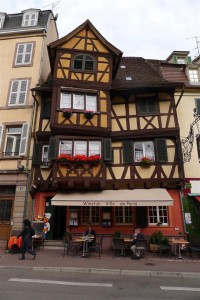 Colmar is located in the Alsace region of France, but its culture is a mix of French and German elements. From the late 1800’s to the mid 1900’s, France and Germany exchanged control of the region four times. Places with names like “Kayserberg“ and “Herrlisheim-prés-Colmar“ reflect that tangled history.
Colmar is located in the Alsace region of France, but its culture is a mix of French and German elements. From the late 1800’s to the mid 1900’s, France and Germany exchanged control of the region four times. Places with names like “Kayserberg“ and “Herrlisheim-prés-Colmar“ reflect that tangled history.
Most striking to me was Colmar’s “Vieux Ville” — the historic town center. Annette and I pay attention to buildings, and we are used to seeing a handful of artfully-restored half-timbered houses in the centers of European towns. But Colmar has what must be hundreds of lovely tipped, sagging, bowed, and angled-but-still-standing half-timbered houses. Neither Annette nor I could recall being in a place where so many half-timbered houses have been so well preserved.
Schmargendorf
I can’t say that I was enthusiastic about living in Schmargendorf when Annette first mentioned that her online searching had turned up an apartment there. It’s not that I knew anything about the area, but the name made me think of Schmaltz, the solidified chicken fat that is enjoyed spread thickly on slices of brown bread. My interest in the area was further tempered when I saw on a map how far it is from the more centrally-located, hipper locales like Kreuzberg, Mitte and Prenzlauer Berg. But the location looked like it would work well for Rani’s school, and it is close to the Grunewald park. The apartment itself is wonderful, and — the clincher, in Rani’s opinion — the kitchen cabinets are bright red.
Outside the center of the city, Berlin feels to me like a tapestry of towns. As the city expanded over time, it absorbed what had been outlying villages with their own town centers and neighborhoods. I read that “Schmargendorf” was first recorded as the name of our area in 1354. Through the 19th century, Schmargendorf was a small farming village on the outskirts of Berlin. By the turn of that century, the village had its own local administration, and in 1920 it officially became incorporated as part of greater Berlin.
This area’s historic town hall or “Rathaus” is adjacent to Mamta’s school, one block over from our apartment. It was built in the year 1900, in a style that is described as “Brick Gothic, with elements of Art Deco.” The building survived WWII largely intact, although the explosion of a bomb nearby blew out the original stained-glass windows.
The Rathaus includes a restaurant in the cellar called — what else? — the Ratskeller. In this case, Rat refers to a council or advisory board — like our hometown of Walpole’s governing selectboard — rather than to a rodent.
Nuts in the City
Mamta has been focused on nuts lately. Not the kind of nuts for which Berlin is famous, but rather tree nuts — acorns and chestnuts, mostly. Her interest, or dare I say obsession, came on gradually. I noticed that getting from one place to another in the city seemed to be taking longer, and realized that it was because Mamta was constantly stopping to gather nuts. She usually hands them to me for transport in my pockets or man-purse (aka bike messenger bag). Shiny brown horse chestnuts are her preferred quarry, but she delights in finely-shaped acorns as well. I began to wonder what was motivating this passion of hers, and why, for that matter, were there so many nuts lying around anyway?
Public Transportation
This year abroad is giving my family and me an opportunity to experiment with our lifestyle. We traded a rural village in New Hampshire for the capital city of Germany. Owning a house for renting an apartment. Croissants from Burdick’s for broetchen from the neighborhood bakery. And a car and a pick-up truck for…public transportation.
We don’t own a car in Berlin. In fact, one of my goals, which is not necessarily shared by the rest of the family, is to refrain from buying a car while we are here. The public transportation system in Germany works well. We enjoy biking around the city. Car-sharing services like Car2go and drive-now are available. Annette’s sister and her parents have cars we might borrow. We could always rent a car in a pinch.
Prior to moving here, I was already familiar with the subway (U-bahn) and tram (S-bahn) services in Berlin. However, since our apartment is not close to stops for either, we have all been getting comfortable with the bus system. It turns out that Google Maps is smart enough to know which buses go where, and when they leave. And the buses generally seem to run on schedule. Most of the buses that serve our neighborhood are double-deckers. Our favorite seats are on the upper level, all the way to the front. The views are great, and the motion of the bus, especially around curves, is exaggerated in a fun way.
Using primarily public transportation may sound good in theory, but there are times when I do miss having a car. I am late for an appointment, I just missed the bus, and the next one is not for twenty minutes. I want to get to IKEA to pick up a flat-packed set of desk drawers that would be unwieldy to carry back on my bike, but the trip that takes 15 minutes by car is over an hour by bus and subway. Rani has volleyball practice across town that ends after dark, and she has to walk blocks through a graffiti-bedecked neighborhood to reach the S-Bahn station. Annette and I are headed home after a late night out, the buses have stopped running, and taxis are scarce. Okay, that last one happened only once, but still…
Die Regenbogenfabrik
Annette and I are rich in bicycles. Most are not thoroughbreds, but they are sturdy and reliable. We pride ourselves on having them stabled in New Hampshire, Boston, Brooklyn and Berlin. When Annette moved to the US from Berlin fifteen years ago, she left behind two bicycles which she stored in the basement of her parents’ apartment. Her parents had given her one of these bikes when she was thirteen. The other dates back to college. Over the years we have dusted off and used these bikes when visiting Berlin.
Within a week of arriving last month to live in Berlin, we had added to our collection of mounts. We bought Mamta a new bike, in the hopes of bolstering her enthusiasm for bicycling — and to better enable her to keep up with us. Annette’s sister Doreen and her husband Stefan both have two bikes each, and Rani and I were able to borrow their “seconds.” Although not much to look at, Doreen’s older bike worked well from the get-go for Rani. The bike I borrowed from Stefan needed some work: the rear derailleur cable was disconnected, the brakes were squishy, a fender was loose, the chain guard was kaput, and one wheel had a serious wobble. Annette encouraged me to bring the bike to a repair shop to have it fixed, but I had other ideas.

